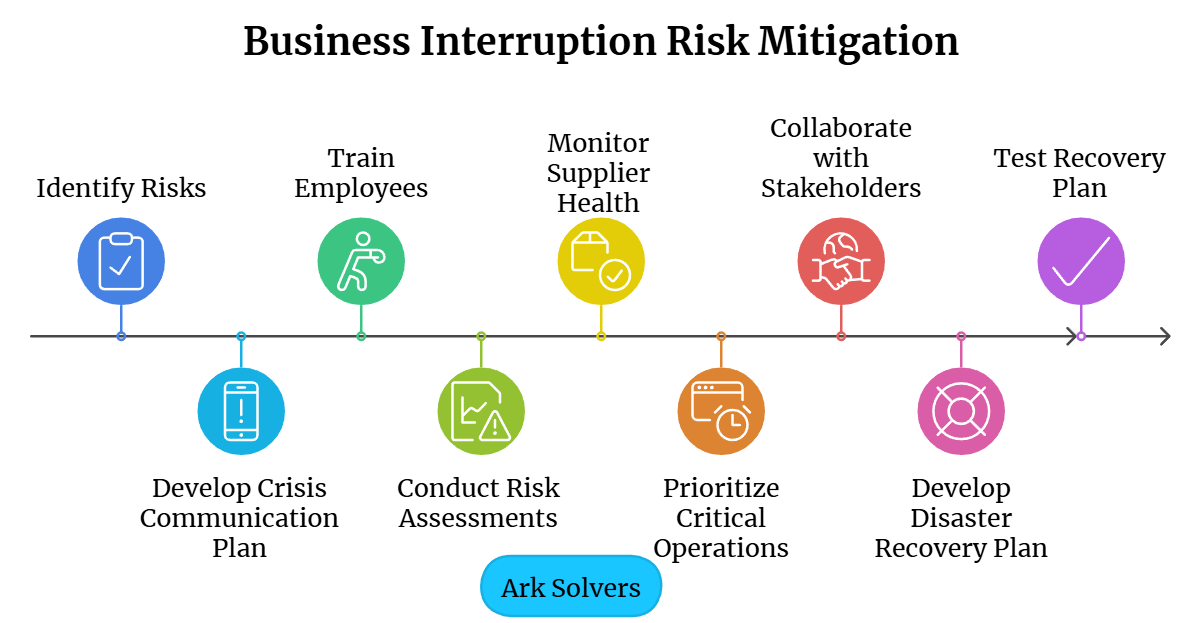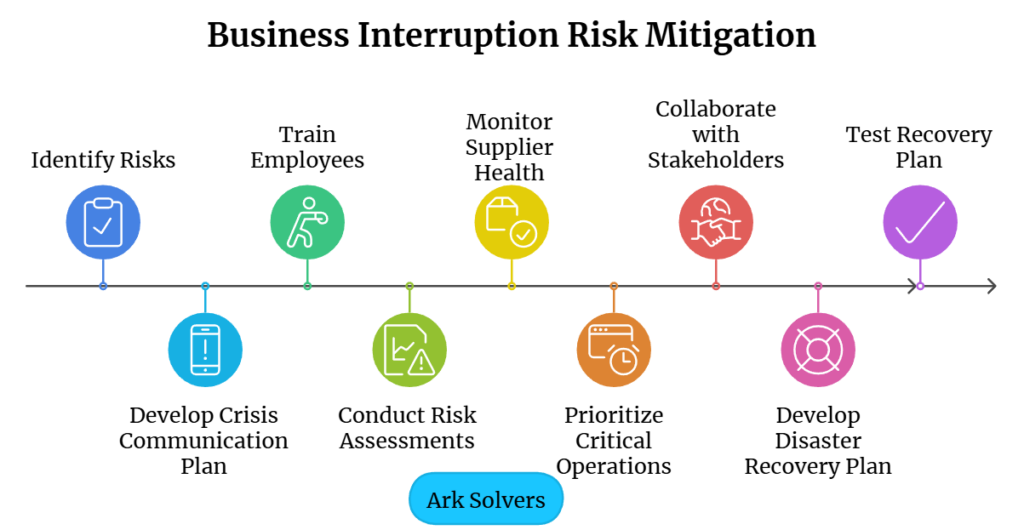How Do You Mitigate Business Interruption Risk?

How Do You Mitigate Business Interruption Risk?
In today’s world, businesses face many unknown challenges. The big question is: how do you protect against business interruption risk? It’s a key issue for every company to tackle to keep its future safe. Business interruption risk means losing money when unexpected events stop operations.
For companies like Ark Solvers, knowing and using good business plans and risk management is vital. This helps them deal with tough times. We will examine how businesses can stay strong when faced with hard times.

Key Takeaways
- Business interruption risk can severely impact revenue and operations.
- Effective business continuity planning is essential for resilience.
- Risk management strategies help organizations prepare for unforeseen events.
- Identifying potential risks is the first step towards mitigation.
- Collaboration with stakeholders enhances business continuity efforts.
- Regular assessments ensure ongoing preparedness against interruptions.
Understanding Business Interruption Risk
Business interruption risk is a big problem for companies. It can hurt their work and their money. Knowing what business interruption risk is means seeing that many things can cause trouble. It’s key for businesses to spot and deal with these risks well.
What is Business Interruption Risk?
Business interruption risk occurs when a company might lose money due to sudden problems. These issues can really mess up a business’s operations. Companies need help to stay profitable when things go wrong, like natural disasters or tech failures.
Common Causes of Business Interruptions
Many things can cause business interruptions. Here are some big ones:
- Natural disasters, like hurricanes, earthquakes, and floods
- Cyberattacks that mess with important info and stop systems
- Power outages that affect tools and processes
- Equipment failures that stop production
- Supply chain problems from vendor issues or logistics issues
Knowing about these interruptions is important for managing risks well. Ark Solvers says it’s key to finding these risks to make smart choices. By knowing where risks come from, businesses can improve their staying power.
Key Steps to Mitigate Business Interruption Risk
Follow a few key steps to lower business interruption risk. First, spot potential risks. Then, plan to keep your business running when things go wrong.
Identify Potential Risks
Start by determining what could go wrong. Do a detailed risk check. This helps companies like Ark Solvers find weak spots that could harm their work.
Make time to check for risks often. This will allow you to find and fix problems before they cause big trouble.
Develop a Business Continuity Plan
Next, create a solid business continuity plan. This plan shows how to act when things get tough, helping keep your business running smoothly even when things go unplanned.
A good BCP is like a map. It guides you on how to deal with problems. This way, you’re ready to act fast when you need to.
Effective Business Risk Mitigation Strategies
A solid plan is essential for a business to manage risks well. It must also act early to protect itself. This means setting up defenses, ensuring that things can keep going even if they don’t, and getting the right insurance.
Implement Preventive Measures
Businesses must take steps to stay safe. This includes:
- Using new tech to keep data safe and fight off hackers.
- Keeping equipment in good shape to avoid sudden breakdowns.
- Teaching workers how to stay safe on the job to cut down on accidents.
These steps help keep a business running smoothly, even when things get tough.
Build Redundancy and Insurance Coverage
Having a backup plan is key. Companies should have friends and extra ways to make things in the supply chain. They should also get insurance, like interruption insurance, to cover lost income when things go wrong. This helps them bounce back faster and feel more secure.
How Do You Mitigate Business Interruption Risk?
To reduce business interruption risk, it’s key to have a good crisis plan and train employees. These steps help keep employees and customers informed and ready for surprises. Good communication can also ease worries and doubts in tough times.
Crisis Communication Plan
A solid crisis communication plan is crucial. It should tell everyone how to share news quickly and clearly. This plan helps keep all groups informed right away when trouble hits.
- Choose who will talk to the media and inside the company.
- Set up a team to handle big problems.
- Use many ways to reach different people.
Ark Solvers says clear communication reduces confusion and keeps everyone on the same page. This is key to keeping business running smoothly.
Employee Training and Preparedness
Training employees is vital in reducing business interruption risk. Regular training gives them the skills to act fast in emergencies. Ready employees can make smart choices, strengthening the company.
- Practice emergency responses in training.
- Keep safety rules up to date and teach them well.
- Give employees places to ask questions and get help.
Ark Solvers believes a confident team leads to better responses. This protects the business and its people from long disruptions.
Regular Risk Assessments and Monitoring
Regular risk assessments are key for businesses to stay ready for changes. Companies must always check for risks and update their plans. This helps find and fix problems before they cause big issues.
Conducting Thorough Risk Assessments
Using good risk assessment methods is crucial for making smart choices. Businesses should do detailed checks on many things. These include:
- Operational processes
- Market changes
- New tech
- Law updates
This helps companies get ready for problems and use their resources well.
Monitoring Supplier Health and Stability
Watching how suppliers do is also very important. Companies must check if suppliers can keep up, especially in tough times. Ark Solvers says good supplier relationships help a lot.
Checking on suppliers often helps keep supply chains strong. This makes sure businesses keep running smoothly.
Minimizing Business Interruption Impact
Keeping your business running smoothly is key when unexpected things happen. A good plan focuses on the most important parts of your business. This way, even when things get tough, you can keep going.
Companies need to figure out what’s most important for them. This helps them use their resources wisely.
Prioritize Critical Operations
Companies like Ark Solvers know how important it is to focus on the basics. They ensure that the most important parts of their business keep running, which helps them avoid long breaks and continue serving their customers.
This strategy includes:
- Figuring out what makes the most money.
- Keeping everyone in the loop with clear communication.
- Teaching staff how to keep things running smoothly.
Cost-Benefit Analysis for Mitigation Strategies
Looking at the costs and benefits of different plans helps businesses make smart choices. This way, they can decide where to spend their money wisely and see if their investments are worth it.
- Finding the best ways to keep things running smoothly.
- Understanding the financial risks of different problems.
- Helping everyone make better decisions.
Read More: How Much Does a Business Continuity Plan Cost?
Collaboration with Stakeholders
Effective risk mitigation requires the help of many, such as employees, suppliers, and customers. Working together with stakeholders is key. It makes everyone feel they’re part of the solution during tough times.
Importance of Engaging Stakeholders
Getting stakeholders involved is vital for a strong continuity plan. Each one offers different views, improving the plan. This way, businesses can handle surprises better.
Creating a Continuity Plan Together
When everyone helps make a continuity plan, it works better. Ark Solvers knows that shared effort leads to better results in crises. This teamwork makes the plan stronger and the business more resilient.
Disaster Recovery Planning
Every organization needs a good disaster recovery plan. It helps them get back on track fast after problems. Ark Solvers makes plans that fit each business, helping them stay strong during tough times.
Developing Disaster Recovery Solutions
Creating strong disaster recovery plans means knowing what could go wrong. Companies need to figure out what they need and make plans that fit. This way, they can get back to normal quickly after a problem.
Testing Your Disaster Recovery Plan
It’s important to test your disaster recovery plan often. Drills and checks help find and fix any weak spots. Ark Solvers says testing keeps the team ready and confident to act quickly in emergencies. By always improving their plans, companies stay ready for anything.
Also Read,
What is Global Business Continuity Management?
Effective Business Continuity Strategy: A Complete Guide
Conclusion
In today’s fast-paced world, knowing how to handle business interruptions is key. Companies must prepare for surprises that could stop their work. This article shows how to keep things running smoothly and avoid big problems.
Identifying risks and making good plans are the first steps. Then, it is important to take steps to prevent problems and talk clearly in crises. Ark Solvers says being ready for risks is crucial. It helps businesses deal with challenges well.
Acting fast can protect a company’s work and keep it stable. It’s important to always check and update plans for risks. This way, companies can stay strong when things get tough, keep up with challenges, and stay ahead with a good plan.
FAQ
What is business interruption risk?
Business interruption risk occurs when unexpected events prevent a business from working as usual. These include natural disasters, cyberattacks, and supply chain problems. They can really hurt a business’s ability to keep going and work well.
How can a business reduce the risk of a business plan failing?
It’s key to have a good plan for keeping things running to lower the chance of a business plan failing. This means doing risk checks often, making a solid plan, and training workers for when things go wrong.
What are the most common causes of business interruptions?
Power outages, broken equipment, cyberattacks, and supply chain problems are common reasons for business interruptions. Taking steps to prevent these can help keep a business running smoothly.
How do you mitigate business interruption risk?
To lessen business interruption risk, identify risks, make a strong plan, and take steps to prevent problems. Also, have backup plans, get the right insurance, have a crisis communication plan, and train employees on emergencies.
What strategies can be used for effective business risk mitigation?
Good strategies for managing business risks include preventing problems, having backups, getting the right insurance, and conducting risk checks. These help keep a business safe from threats.
How can a crisis communication plan aid in mitigating business interruption?
A good crisis communication plan helps keep things clear and calm when things go wrong. It ensures everyone gets the right information, helping the business respond better to disruptions.
Why is regular risk assessment important for businesses?
Regular risk checks are key to staying safe from new threats. They help businesses identify their weak spots and update their plans to prepare for surprises.
How can organizations prioritize critical operations during a disruption?
Businesses should prioritize key operations during a crisis. This will allow them to use resources wisely and keep important work going even when times are tough.
What role does collaboration with stakeholders play in business continuity?
Working with stakeholders like employees, suppliers, and customers is very important. It builds trust and helps everyone work together to keep the business going during emergencies.
How can disaster recovery planning help organizations rebound after an incident?
Disaster recovery planning involves making plans that fit a business’s needs and knowing how to act in emergencies. Testing these plans helps find and fix problems so a business can bounce back quickly after a crisis.


